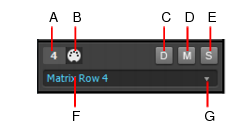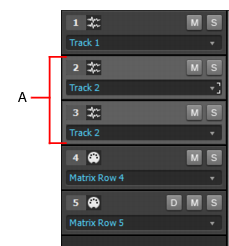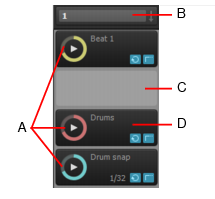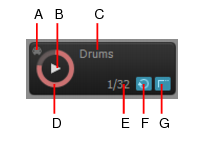Figure 667. The Matrix view.





. When the Stop All Cells button is enabled, all playing cells stop. The small arrow next to the Stop All Cells button lets you access a drop-down menu with the following commands:



. When the Capture Matrix Performance button is enabled, you can record the current Matrix performance into the Clips pane during playback. Rows are recorded to their assigned output tracks. For details, see To record a performance into the Clips pane. You can also perform a Quick Capture of a single pattern. For details, see To render a single pattern to the Clips pane (Quick Capture).

. This toggle lets you specify if the Matrix view should follow Sonar’s main transport (Play/Stop) commands. When Follow Transport is enabled, patterns will only play when Sonar’s transport is rolling. When Follow Transport is disabled, you can play the Matrix while Sonar’s transport is idle (if you start Sonar’s transport in this mode, cells that are already playing will immediately update their positions to synchronize with Sonar’s transport). For details, see To synchronize the Matrix with Sonar’s transport.

. This menu lets you specify the time lag between when you trigger a column or cell, and when it starts/stops playing. The options are as follows:








/
. This toggle lets you specify if a triggered cell should repeat indefinitely, or stop when it reaches the end. When Loop is enabled
, a triggered cell loops indefinitely. When Global Loop Mode is disabled
, a triggered cell plays once then stops. This option is enabled by default.

/
. This toggle lets you specify if a triggered cell should stop or keep playing after you release the mouse button or MIDI key. When Global Latch Mode is enabled
, a triggered cell will continue to play after you release the mouse button or MIDI key. When Global Latch Mode is disabled
, a triggered cell will stop playing when you release the mouse button or MIDI key.





/
. This toggle lets you specify if a cell should stop or retrigger from the beginning if triggered during playback. When Retrigger Mode is enabled
, triggering a playing cell will restart the cell from its beginning. When Retrigger Mode is disabled
, triggering a playing cell will stop the cell from playing.

/
. This toggle lets you specify globally if a pattern should start from the beginning of the pattern, or if playback may start in the middle of a pattern in order to synchronize with the project’s Now time. The two modes are as follows:

. When you trigger a cell, the pattern will start playing from the beginning of the pattern, after the amount of time listed in the Trigger Resolution menu.

. When you trigger a cell, the pattern will start playing in sync with the Now time after the amount of time listed in the Trigger Resolution menu. It’s as if the cell’s pattern is repeated throughout the song and you unmute the pattern at a certain point. This is the default setting.

. This toggle lets you enable/disable MIDI control over the Matrix view. Click the small arrow next to the Cell MIDI Trigger button to specify which MIDI channel the Matrix view should respond to (select Omni for all channels).

. Click the Options button to open the Matrix Options dialog box. The following options are available:




is enabled, you can queue up multiple cells to trigger when the transport starts. If Follow Transport Restores Pending Cells on Stop is enabled, all cells that were queued up to trigger will be pending again when the transport stops, even if the cells were manually stopped during playback.



/
. The icon indicates if the row contains audio data
or MIDI data
. Rows that are assigned to audio tracks can only contain cells with audio data. Likewise, rows that are routed to MIDI or Instrument tracks can only contain cells with MIDI data. The Audio or MIDI identity of a row is established when the first pattern is dragged into the row.

. By default, a MIDI row is routed through the assigned MIDI track, and all track processing is applied, including MIDI FX, Arpeggiator, volume, etc. To bypass all track processing and send a row directly to the soft synth or hardware output that is assigned to the target track, click the row’s Direct Mode button
.























Tip - Searching Documentation
Tip: To search for a specific topic, type your search query in the Search Cakewalk.com field at the top right of this page.
When the search results appear, click which product's documentation you would like to search to filter the search results further.
Note - Using Offline Help
Note: If you prefer to always use offline Help, go to Edit > Preferences > File > Advanced in your Cakewalk software and select Always Use Offline Help.
If you are not connected to the internet, your Cakewalk software will default to showing offline help until an internet connection becomes available.











